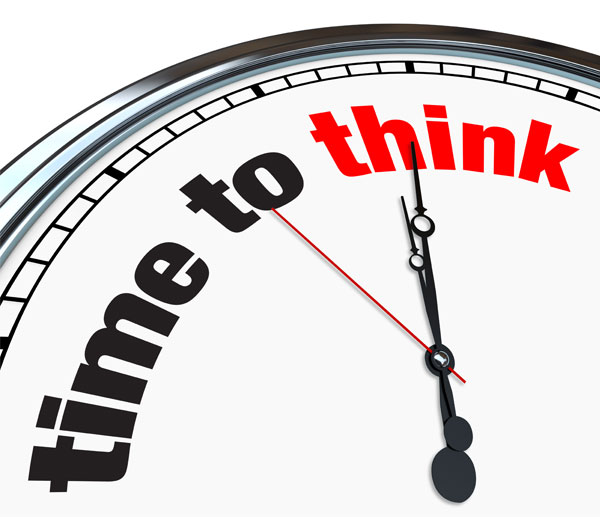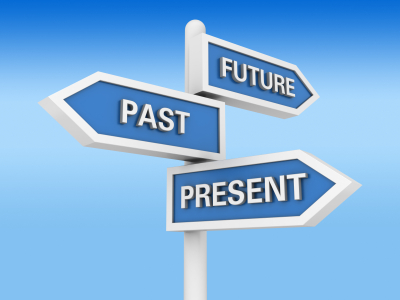Time-Based Considerations
Saturday, February 15, 2014

There is one fundamental element in structuring that is common to solving all problems. That element is time.
Time may be the most enigmatic aspect in problem solving. With nearly unlimited quantities of time, almost anything seems possible. When time is short, your options may be very limited. Time may be your most precious resource.
Predicting the Future
In problem solving, there are some aspects of time that are generally not given their proper importance in my humble opinion. Now, I'm not talking about time management here. I think it's well understood that you need to organize your time because you rarely have unlimited amounts of time to solve your problems without suffering consequences.
One concept that I feel is critically important to understand is causality. More specifically, how an action you set in motion today can set off a chain of events that influences future outcomes. In very complex situations, determining outcomes can seem almost impossible to predict. It can also create quite a dilemma for you, since your ultimate goal is to create a future world where your problem no longer exists (i.e. it's already been solved).
Here's a quote that reframes this issue:
"The best way to predict the future is to create it." - Peter Drucker
Time Perspective

A balanced time perspective is the preferred approach you should use in problem solving. If you're too focused on the past, you can become myopic. In extreme cases, you can become a prisoner, living in your own faded past.
Constantly dwelling on your present problem can be counter-productive, too. If you're obsessed with your problem it can begin to takeover the internal dialog you have with yourself. In essence, you become addicted to your problem.
Being unduly focused on the future has it's dangers, too. If you're fixated on some ideal future, constantly daydreaming, you may want to consider looking for ways to balance your time perspective.
You can use my Past-Present-Future tool to create a more balanced time perspective.
Structuring Time-Based Aspects
There are structural constructs of your problem directly related to time.
You can list your actions (and events) of the past, present, and future in a Chronology or visualize them with a Timeline. This is a situation where applying the concept of structuring can really help to you.
Future vs. Present
You can gain another perspective by creating a comparison between your desired future state and your present reality. You accomplish this by developing a list of future factors and comparing it to a list for your current factors. For help with this exercise, visit my Future State vs. Present Reality tool.
Time Framed Consequences
In some cases, you may have more than one outcome to evaluate. An interesting way to look at each outcome is to create retrospective views from different points in time. This will help you observe the consequences of implementing each alternative. Use my Time Framed Consequences tool to perform this evaluation
Cross Impact Matrix

To examine how the variables in your current situation influence future events, use my Cross Impact Matrix tool.
This method can help you determine the relationships between your variables and show you how much each variable influences the outcome.
Use this tool to help find independent & dependent variables, cause & effect relationships, and assumptions underlying the relationships between the variables.
Causal Flow Chart
Use a Causal Flow Chart to establish a visual framework for analyzing cause and effect relationships. It will enable you to view cause and effect relationships as a whole integrated system and to discover the linkages between driving forces.
Cause & Effect - Fishbone Diagram
A Cause & Effect - Fishbone Diagram will help you visually display the many potential causes of your problem. It is particularly useful at identifying the root causes of your problem.
Sequential Attributes Matrix
My Sequential Attributes Matrix tool can help you find ways to modify the steps in an existing process.
Scenarios Matrix
The Scenarios Matrix tool was designed to examine your drivers across a full-range of possible scenarios.
Indicators
Indicators are pre-determined observations that you can list to track your scenarios. Following these predictive indicators can determine if a scenario is becoming more or less likely. Use my Indicators tool to create your list of indicators.
Indicators Matrix
Use my Indicators Matrix tool to examine the diagnostic power of your indicators. Your best indicators will show that one of your scenarios is more (or less) likely to occur than all of the others.
High Impact / Low Probability Analysis

This technique is helpful when unanticipated developments suggest that a “long-shot” scenario has become more likely.
One of the keys to performing this analysis is to assume an unlikely scenario has already occurred and then determine its impacts.
The High Impact / Low Probability Analysis tool is used to raise awareness of the major impacts from an unlikely outcome (that has become more likely).
Your Problem and the Time Continuum
As in life, problem solving happens on a time continuum. Your problem has been traveling on a path through time. It originated somewhere in the past and your solution resides somewhere in the future. Now your problem is here, at this point in time, in its present state. The decisions you make (or don't make) will most certainly determine what trajectory you'll travel on.

Aim at Your Solution
Think about the ways that you can influence the trajectory using your problem solving activities. How do you move in a direction that will get you closer your solution? How do you get there in the most effective manner?
Your problem solving activities are immersed in time. You'd be wise to constantly guide those activities that are under your control on a path that leads directly to your best solution. If you want to hit your target, you'd better aim carefully and stay on your target.
by Keith Glein, Founder & CEO
